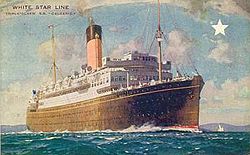Orca (ship)
|
||||||||||||||||||||||||
|
||||||||||||||||||||||||
|
||||||||||||||||||||||||
|
||||||||||||||||||||||||
|
||||||||||||||||||||||||
The Orca was a steamship of the British shipping company Pacific Steam Navigation Company put into service in 1918 , which was planned as a passenger ship, but could not be used as such by its shipping company due to the outbreak of the First World War . In 1927 she was sold to the White Star Line and was in service under the name Calgaric until the end of her service.
The ship
The steel steamer Orca was built at the Harland & Wolff shipyard in Belfast , Northern Ireland . The measurement of the ship amounted to 16,063 GRT, 12,703 tons below deck and 9,014 NRT. The ship was 167.7 meters long and 20.5 meters wide and had a maximum draft of 13.1 meters. Two decks covered with steel and wood spanned two decks made entirely of steel . The protective deck was planked with teak .
The Orca was equipped with ten watertight bulkheads , a false bottom , electric lights , as well as apparatus for tracking down submarines ( submarine hunting ) and for wireless telecommunications . She was with eight-cylinder Dreifachexpansions- steam engines and a low pressure turbine driven by Harland & Wolff, the three propellers worked. The six double-ended steam boilers had a total of 26 furnaces. The Orca's callsign was JTLW. She was the last of three sister ships to be completed . The others were the Orduna (14,499 GRT, 1914) and the Orbita (15,495 GRT, 1914), both of which could be put into service before the outbreak of war.
history
Since the Orca , which was launched on January 15, 1918, was completed during the First World War , it was no longer used as a passenger ship by Pacific Steam Navigation, but served as a cargo ship and troop transport during these years . With 15,753 tons of cargo, the Orca set a new record for the ship that carried the most cargo through the Panama Canal . In 1921 the Orca was returned to its shipyard in order to finally convert it into a passenger ship. The renovations were completed in December 1922.
In 1923, the Orca, along with her sister ships Orduna and Orbita, was bought by Royal Mail Line , which had previously chartered all three ships. On January 3, 1923, the Orca set off on its first passenger journey from Southampton via Hamburg to New York . She stayed on this route until December 1926. In 1927, the Royal Mail Group, to which the Royal Mail Line belonged, took over the White Star Line . The Orca was given to White Star and renamed Calgaric . The new addition to the White Star fleet was able to carry 290 passengers in first class, 550 in tourist class and 330 in third class. On May 4, 1927, the ship set sail for the first time under the flag of the White Star Line. It was used on the route from Liverpool to Montreal until it drove from London to Montreal from 1929 .
After the ship was used intensively for cruises , it was first laid up in Milford Haven in September 1930 and then used only irregularly. On June 9, 1933, it was back on the Liverpool – Montreal route, but on September 9, 1933, it was launched again in Milford Haven. In 1934 the Calgaric became the new Cunard-White Star Ltd. transferred, but already broken up in 1935 without ever being used by Cunard-White Star.

